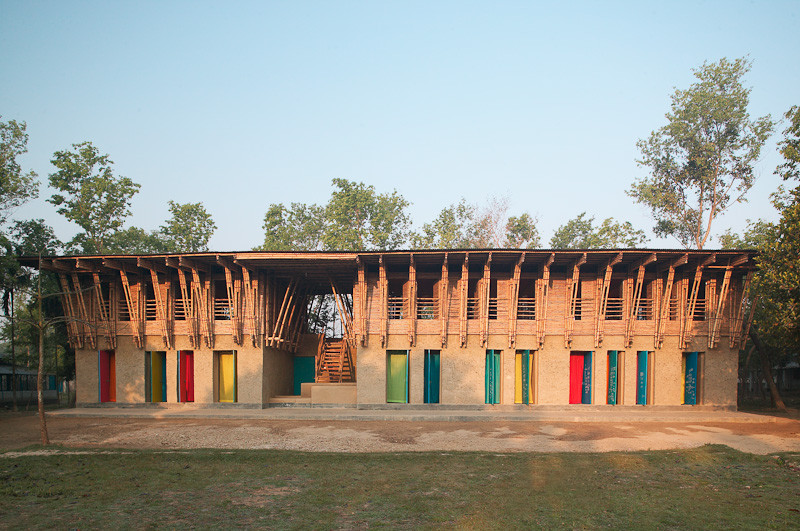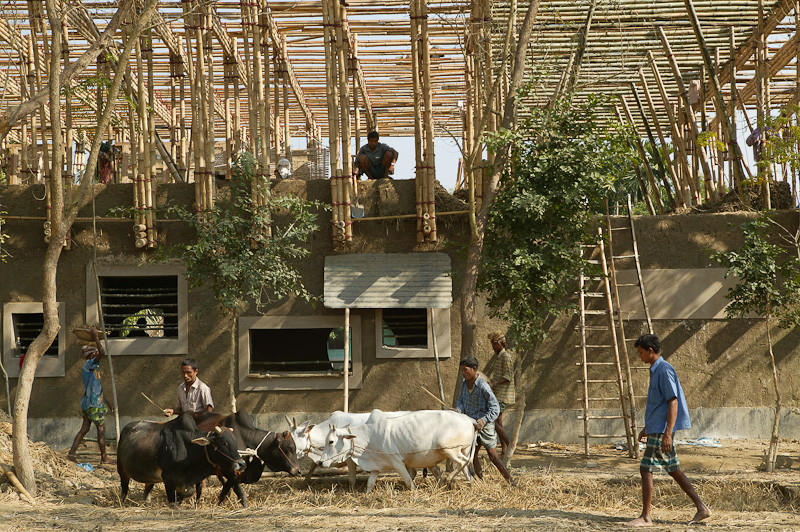
Project Name: METI Handmade School
Location: Rudrapur, Dinajpur district, Bangladesh
Date Designed: 2005
Date Completed: 2006
Size: 325 sqm
Client: Modern Education and Training Institute
Programme: Education
ABOUT Studio Anna Heringer
Studio Anna Heringer is headed by Anna Heringer herself, a German Architect who strongly advocates for the use of mud and bamboo as sustainable materials for construction. Although these materials are considered ‘low-class’ in the building industry, Anna believes that they are not inferior in their properties and pioneered the utilisation of these resources in communitydriven architectural projects in Bangladesh. Anna defines that ‘sustainability’ is about “the quality of life and the celebration of nature’s vast resources”, and always pushes for community involvement in her projects to bring people together and generate collective ownership while honouring the abundant natural resources that the Earth has provided for us.
ABOUT METI Handmade School
METI Handmade School is commissioned by a non-government organization called the Modern Education and Training Institute and is a learning institution built for training children to be ready for creative trade-based industries. In Bangladesh, where the project is based, the local knowledge on building materials such as Earth and Bamboo was limited and had not been successfully implemented as a material in the local projects. Anna made use of this opportunity to introduce experts in the architecture industry to educate the local tradesmen and community on and improved traditional building methods using these local materials.

Cultural Block Östersund
Insights and Takeaways
ADVICE TO YOUNG ARCHITECTS?
You always do best when you do things that you believe in. You shouldn’t follow the stream of money, but should follow their calling. Everybody has a special talent, and if you follow that, life will support you. It makes no sense that you have special talents, and then life shutting the door. Maybe in beginning it is difficult to do it 100%. For me, I would do one-third on the “heart job”, the one that you believe in. One-third doing the “bread job”, you can do anything that pay your bill as long as it is ethical. For the other third, try to simplify your life, cut down your consumption, raise your creativity. The more you design your life, your creative life, the happier you are. Life is not just about consuming, it is about being, about creating, about living.
Interview Transcript
Q1: Many of your projects have been developed based on the Laufen Manifesto, which advocates for a more humane design culture in the face of the widespread non-formal urbanism taking place across the globe. Based on your real-world experience, why has there been a greater need for such a humane design approach?
The climate and health is on our side; and also the need of doing good, meaningful buildings. To make good-looking architecture is a basic thing for architects. There are so many goodlooking architecture all around. But to have not just good-looking, but also humane and sustainable architecture is something we really long for. We also need identity, and that comes with the process, not just the outcome. I think the focus on process is increasing. With the current COVID-19 pandemic, at least people’s consumption is more careful. For the fair textile project in our office, it was difficult to sell before the crisis; now with the crisis I have a feeling that people are willing to buy something that is not just good-looking but they know they are also doing good somewhere else. There is now certainly a greater need for humane design. When everything is so fast we don’t have time to reflect, we just go with the flow. Now that the flow is interrupted, it also gives us a chance to think over, how we want to continue and where we want to focus on.
Q2: In a field dominated by contemporary trends, how did you get others to come onboard this vision of architecture? Is this a problem you still face today?
Yes it’s really challenging. The biggest challenge is always the fear. The image of vulnerability of natural material is something that is so dominant, and it has always been emphasized by the lobbyists in the past decade – “mud is weak”, “wood is week”, “bamboo is weak”. There is a lot of superstition that we are trying to erase, and that requires the biggest energy, effort and time for every project, as we try to raise the trust of the clients to believe in us.
There are also not so many facts and figures. Normally when a material is invented, you have an industry behind that is paying for all these tests, and once you have the numbers, it’s easy for architects to use it. With mud, of course it is not a standardized material, because nature is not standardized. You have the diversity, that is also the nice thing. But there is no industry behind. Ideally every city needs to have a manufacturing plot, and the material properties would be different at every place, which is kind of difficult. In Germany, we have to do a lot of test for material, which will cost a lot of money. In Switzerland, you don’t have to do that. In Austria, it depends on the mayor. For example, when you go to the mud house you can hear good acoustic, but you can’t prove it because you don’t have the money to invest in testing. Even for fire-proofing, what happen when mud is met with fire? The worst case is that mud will just turn into bricks! So it’s very difficult sometimes for the project when it is highly regulated which raises the cost unnecessarily. But it’s still possible, you just need to have enormous energy to push constantly for it to happen.
Q3: Urbanisation is increasing, and it is projected that 68% of the world’s population will be situated in cities come 2050. How do you see your philosophy of humane design working with local material could apply in denser urban context?
Well, natural material is everywhere. Normally you don’t dig and find cement under your feet. Labour force is also there. You can’t go extremely high with mud, you can go multi-storey, but the question is how high can you go such that it is still a humane, liveable city. If you go too high, you lose the contact with the street. For me, Paris is the ideal height – tree height, six storeys. It is also very dense. Is it better for us to focus on only mega cities? Or should we not also look at the regional sub-centre where we can decrease the height a little bit, and really concentrate on a humane scale and liveable spaces. In city we need to use different technology. Of course, you won’t have the water buffalo doing the concrete mixing. But you can have prefabrication. You can have the machine taking over the hard work, and then have people to mount the blocks together, that is absolutely possible.
The denser the city you live in, the more you need material that you want to touch. In all the projects we have done, people are constantly trying to touch the wall. I think it would be so nice in the city where we could feel physically attracted to natural material, material that we feel in harmony with. You can have concrete framing, but then filled with mud, and you would have a much better climate during the monsoon season.
Q4: As the world is getting more digitised by the day, how would you see the intersection between technological advancement and local, indigenous design?
I think there is always this fascination for the new invention. In the field of architecture and engineering the focus was very much on new exciting material. But I think there is such an incredible wisdom in the indigenous methods, logics, to build with what you can find on the site, what is given by nature for free, and how to make the best out of it. And to relink our contemporary architecture with this kind of ancient materials and building methods, to me, is totally fascinating! For me, they are not contradictory, as we can build in very modern way, in very modern language, with very old material. It is our core capacity as designers to use material; it is just a matter of creativity. We are not trying to promote a really old fashion lifestyle. I am also having a mud house at the back, where you can have a very comfortable space. Mud is a humidifier – when it is humid the mud just soaks up all the humidity, and when it is dry the mud releases it, it creates a perfect balance of humidity. It is super high-tech in a way, if you have a wall that is naturally balancing humidity, without using any electricity! They are natural materials but they can have high-tech performances in the most effective way.
Movement everywhere started with a few people. In Europe some buildings was built completely with wood, but no one would do this 30 years ago. Now even high rise timber building is possible. Things are changing. In the beginning people would think that it is a crazy idea, but it is not crazy if you know that the most widely used material on this planet is earth. About 3 billion people living in earth houses. It is just not our focus. It is also not a problem of scaling up as it is already in such high number, but it is how we connect it with our needs, aspirations, our current society. We can only make it approved one building at a time. We need a lot of young architects to join this effort. I see a lot of interest in earthen architecture wherever I teach, whether in Harvard or Zurich. I also see that it is because the element connects with something deeply embedded in us, every culture has a special relationship with mother earth. It is not just a building material.